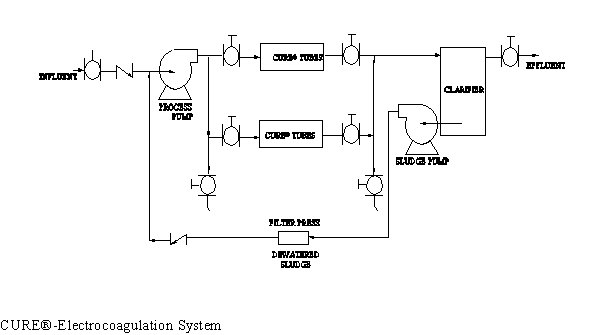
The CURE®-Electrocoagulation (CURE®) system is designed to remove ionic metal species and other charged particles from water (see figure below). Because many toxic metal ions such as nickel, lead, and chromates are held in solution by electrical charges, they will precipitate out of solution if they are neutralized with oppositely charged ions. The CURE® system is effective at breaking oily emulsions and removing suspended solids. The system improves on previous electrocoagulation methods through a unique geometrical configuration.

The CURE® system's patented geometry maximizes liquid surface contact between the anode and concentric cathode electrocoagulation tubes, thus minimizing the power requirements for efficient operation. The CURE® system allows the contaminated water to flow continuously through the cathode tube, enabling a direct current to pass uniformly through a water stream. The contaminated water then passes through the annular space between the cathode and anode tubes and is exposed to sequential positive and negative electrical fields. Typical retention time is less than 20 seconds. Water characteristics such as pH, oxidation-reduction potential, and conductivity can be adjusted to achieve maximum removal efficiencies for specific contaminants.
After the treated water exits the electrocoagulation tubes, the destabilized colloids are allowed to flocculate and are then separated with an integrated clarifier system. Polymers can be added to enhance flocculation, but in most cases they are not required. The sludge produced by this process is usually very stable and acid-resistant. Tests have shown that sludges produced by the CURE® system pass the toxicity characteristic leaching procedure (TCLP) and are often disposed of as nonhazardous waste.
The CURE® system can treat a broad range of dissolved metals, including aluminum, arsenic, barium, cadmium, chromium, cyanide, iron, lead, nickel, uranium, and zinc. The system can also treat contaminants such as emulsified oils, suspended solids, paints, and dyes. Radionuclides were removed by the system at the Rocky Flats Environmental Technology Site (RFETS).
Because this system treats a wide range of contaminants, it is suited for industries and utilities such as plating, mining, electronics, industrial wastewater, as well as remediation projects.
This technology was accepted into the SITE Demonstration Program in 1993. A bench-scale test of the technology was conducted in April 1995 to determine the ability of the system to remove radionuclides from solar evaporation water at RFETS. The system removed over 90 percent of uranium and plutonium from the test water. The technology was demonstrated during August and September 1995 at RFETS under a joint agreement between the Department of Energy, the State of Colorado, and EPA.
The technology has also been demonstrated at several private industrial facilities and is currently being used to remove metals and oily wastes from the following: plating wastewater at a jewelry manufacturing facility, industrial wastewaters from an engine manufacturing facility, cooling tower water at an industrial facility, and for several other industrial applications in the U.S. and internationally. Full- or pilot-scale units are available from General Environmental Corporation.
During the SITE demonstration, four 3-hour test runs were conducted at RFETS over a 2-week period. Prior to the demonstration, operating parameters were adjusted during several optimization runs.
The demonstration showed that the system removed 30 to 50 percent of uranium and 60 to 99 percent of plutonium from the solar pond water at RFETS. The radionuclide and metal content of the dewatered sludge indicated that these contaminants were highly concentrated in the sludge. Uranium and plutonium were only slightly leachable by TCLP and no metals were leachable by TCLP. These results suggest that the sludge is very stable and resistant to breakdown.
The Demonstration Bulletin (EPA/540/MR-96/502), Technology Capsule (EPA/540/R-92/502a), and Innovative Technology Evaluation Report (EPA/540/R-96/502) are available from EPA.
EPA PROJECT MANAGER:
Steven Rock
U.S. EPA
National Risk Management Research Laboratory
26 West Martin Luther King Drive
Cincinnati, OH 45268
513-569-7149
Fax: 513-569-7105
TECHNOLOGY DEVELOPER CONTACT:
Carl Dalrymple
General Environmental Corporation
9025 East Kenyon, Suite 312
Denver, CO 80237
303-889-5949
Fax: 303-889-5946
Dan Eide
CURE International
1001 U.S. Highway One, Suite 409
Jupiter, FL 33477
561-575-3500
FAX 561-575-9510